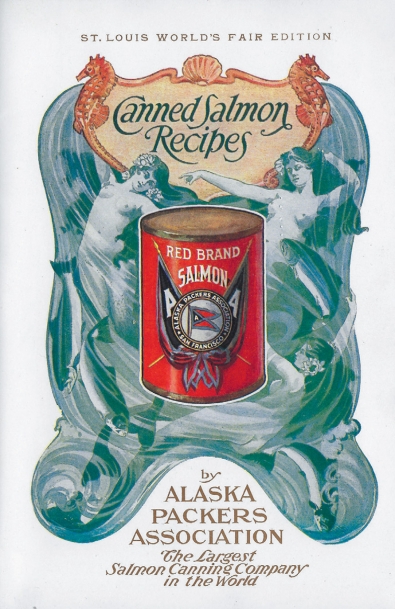How to Eat Canned Salmon
Alaska’s canned salmon industry grew rapidly at the turn of the 20th century. The competing canneries fought among each other to control the catch, cannery locations, even access to fresh water. After a particularly bruising round of corporate street fighting with its competitors, the largest salmon canner, the Alaska Packers Association (APA), tried a new approach.
In 1904, they went to the World’s Fair in St. Louis and introduced the industry’s first recipe book. Rather than fight over production, the APA looked to increase demand for canned salmon.
The 64-page, 5-by-8-inch, leather-bound cookbook was titled How to Eat Canned Salmon and included the choicest recipes of the “largest salmon canning company in the world.” Richly illustrated, the cover page depicted salmon and nude women swirling in a whirlpool around a can of APA Red Brand Salmon.
The APA extoled the nutritious and appetizing value of canned salmon. “Its culinary advantages are numerous and exceedingly valuable,” they boasted. “It may be used where a plain dish is desired, without preparation, for the fish is so thoroughly and scientifically cooked and sterilized during the process of canning, that it is ready for use when opened.
“On the other hand, it affords an amplified opportunity for the highest ability and genius of the experienced cook. It is always ready for immediate use when the unexpected visitor happens in at meal time, or can be made to fill the most elaborate demands of a full course dinner.”
Before offering any recipes, the APA had to give instructions on how to open a can. Canned foods gained increased popularity during the Spanish-American War but were still relatively new. The way consumers opened a can in 1904 wasn’t how we do it today.
The cookbook followed with 90 recipes for breakfast, luncheon, and dinner. There are suggestions for salmon soups and chowders, salads, entrées, chafing dishes, and sandwiches. A final chapter includes recipes to make sauces: mayonnaise, hollandaise, and tartare.
Some recipes were simple. Cold Salmon, for example, didn’t require anything. “A can of salmon is delicious when eaten cold, just as it is taken from the can.” But they suggested dressing it up with béarnaise, mayonnaise, or tartare sauce and a garnish with hard-boiled eggs and sprigs of parsley.
Boiled Salmon was also pretty easy: “Place can in saucepan and cover with boiling water for fifteen minutes. Serve hot with Hollandaise sauce.”
Others were more complex: they offered three variants of salmon croquettes and salmon fritters. They were Salmon Mousalines, Salmon on Rizzota, Canned Salmon Russian Style, Swedish Timbales, Salmon Kromeskies, Salmon Cutlets (“shape like cutlets”), and Salmon en Surprise.
The APA reached out to the military, which used salmon during the Spanish-American War. A chapter on “Army and Navy Dishes” featured artwork that depicted then-President Teddy Roosevelt’s “Rough Riders” eating canned salmon among palm trees, with the battleships of the Great White Fleet in the background.
A recipe for an “Army and Navy Scouse” calls for a can of salmon, a can of tomatoes, 3 hard tack, a quarter pound of salt pork, and a pound of potatoes. Season to taste. Camp Mess Salmon Bake is basically the same, only baked.
The 1904 recipe book was richly illustrated with drawings of serving suggestions, fishing boats working among icebergs, crusty fishermen, mermaids, Alaska Natives, polar bears, and Neptune with a salmon impaled on his trident.
How to Eat Canned Salmon was reprinted multiple times over the following decades, usually in a shorter, smaller format, and targeting specific APA regional brands. Others followed their lead and published their own recipe books with names like Magic Entrées to make with Canned Salmon, Bumble Bee’s Seafarer Favorites, Libby’s Tasty Touches, and Canned Salmon Thousand Dollar Prize Winning Recipes.
One hundred years later, APA had been sold, and many of its canneries have been abandoned. Americans no longer needed to be told how to open a can, and their tastes have changed. Deep fat-fried salmon croquettes have been replaced with recipes for Wild Alaska Salmon Kimchi Burgers and Salmon Quinoa Cakes, each made from canned salmon.
Alaska salmon production today largely focuses on fresh and frozen fish, but a market remains for canned salmon. Tasty, high protein and shelf stable, canned salmon remains a convenient seafood product whether for a simple lunch or the “amplified opportunity it affords the genius of the experienced cook.”
An excerpt from Tin Can Country, edited by Anjuli Grantham and published by Clausen Memorial Museum. Shared with permission. Originally published in issue #13, Fall 2019.




